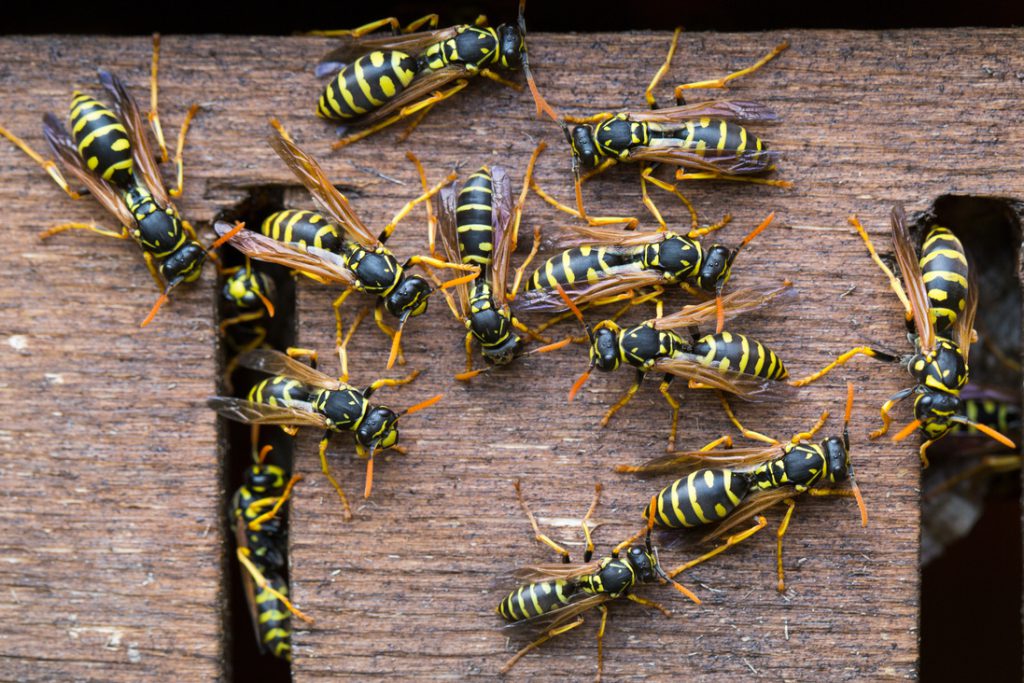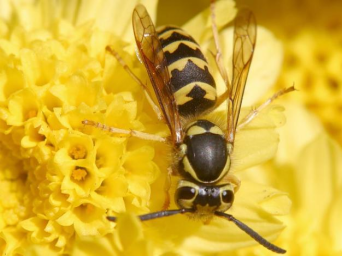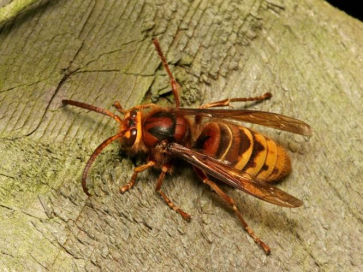How to get rid of wasps (safely)

Looking for how to get rid of wasps? You’re in the right place for a sting-free summer.
Wasps are a common problem for Brits hoping to enjoy a sunny afternoon barbecue in the garden. These stripy insects are attracted to our homes for several reasons: the availability of food, potential nesting space, bright flowers and site fidelity, where wasps return to the same place each year.
While annoying, wasps play an important part in the natural environment, helping with both pest control and pollination.
However, they’re also considered pests in domestic settings. If you’re struggling with wasps, read on. Here, we look at the different types of wasps, how to deter wasps from nesting in your home, and the best way to get rid of wasps.
A closer look at wasps in the UK
When we think of wasps, the first thing that comes to mind is the black and yellow kind that buzz around our summer parties. However, there are over 7,000 species of wasps living in the UK, the majority of which are parasitoids who lay their eggs on or in other insects, such as caterpillars, not in nests. These wasps do not sting or bite, and they don’t have nests which they feel compelled to protect.
Many species of wasps are beneficial to your garden. Although not as well known for this as bees, wasps are important pollinators. And they also help with pest control, feeding insects like caterpillars, aphids and flies to their young.
Not all wasps species behave in the same way. They have different nesting habits, and some are more aggressive than others. Some wasps are social, but many are solitary. Therefore, it’s important to identify what type of wasp you have cohabiting with you before planning their eviction.
What are the most common species of wasps in the UK?
The most common species of wasp in the UK — and likely the ones causing any nuisance to your summer parties — are the common wasp (Vespula vulgaris) and the German wasp (Vespula germanica). They are similar in size, between 12 and 15mm, and are also similar in appearance, both largely yellow with subtly different black markings, hence their common name “yellow jackets”.
Common wasp (Vespula vulgaris) – Image Source

German wasp (Vespula germanica) – Image Source
Both are social wasps and have a single queen who produces between 6,000 and 10,000 workers in grey papery nests which can reach 25cm in diameter. They most commonly nest in the ground or on roofs of houses. Worker wasps tend to look for food more fervently in late summer, as their typical food sources disappear.
Due to their scavenging and nesting habits, they are the wasps most typically found around homes.
Other common wasps species in the UK include:

The less aggressive European hornet is often found nesting in trees and bird boxes.
How to keep wasps away from your home
There are some preventative measures you can take to stop wasps from being attracted to your home in the first place.
1. Keep food covered
Food outside or near open windows and doors will attract wasps unless covered.
2. Keep rubbish bins closed tightly
This includes food waste. Wasps are attracted to bins, especially if there is sweet-smelling food waste or packaging inside.
3. Keep your garden clean
If you have fruit trees in your garden, pick up any fallen fruit as the smell of ripe and over-ripe fruits will attract wasps.
4. Use strong scents
One way of doing this is to make repellent mixtures which you can spray around your house and on their chosen nesting grounds. Research shows that there are a number of essential oils which can deter wasps.
So, what smell keeps wasps away?
A combination of clove, geranium and lemongrass oilsA combination of rosemary, clove, geranium and lemongrass oilsPeppermint oil
Put a few drops of the oil into a spray bottle with water, add a few tablespoons of dishwashing soap and shake. (Essential oils on their own will not harm the wasps). Spray this mixture onto established nests to get rid of existing wasps. To deter potential wasps, spray around your house and property in places which might be attractive nesting places, such as roofs, windowsills, eaves, ledges and garden sheds.
Make sure you spray any locations where wasps have previously nested. Some wasps tend to return to the same place to build their nests each year. They spray pheromones onto their nesting site and then return following the scent.
5. Use spirit vinegar (how to get rid of wasps with vinegar)
Wasps dislike the smell of white vinegar. Spraying a mixture of white vinegar and water can help keep wasps away. It’s important to note that apple cider vinegar will have the opposite effect, as it is attractive to wasps.
6. Plant strong-smelling plants
Some plants can be used as natural wasp repellents and can be planted in your garden, in hanging baskets outside and in pots inside your house. Examples of these are spearmint, thyme, eucalyptus, bay leaves, geranium flowers and other scented herbs.
7. Burn citronella candles
Like mosquitoes, wasps dislike the smell of citronella. Burning citronella candles or burning citronella oil in an oil burner or diffuser can help repel these pests.
Bear in mind that while these methods will deter wasps, to eliminate them you need to get rid of their nest. To keep wasps from returning to the same nesting spot, you need to mask the scent of their colony.
How to get rid of wasps (safely)
If you’ve decided to remove a colony of resident wasps yourself, there are a few crucial steps to follow. Unlike ants, wasps’ defence mechanisms make them a little more difficult to eradicate. Before tackling a wasp nest, it’s a good idea to make sure you’re well prepared.
1. Wear protective clothing
Always approach a wasp nest well-covered. The best outfit to wear would be a bee-keeping suit, but since most of us don’t have one of these at hand, wear multiple layers of long clothing made of thick, tightly woven fabric. Make sure your ankles, wrists and neck are covered. Also wear gloves, protective goggles, a hat, and a scarf wrapped around your face.
2. Locate the nest
When seeking out resident wasps, be cautious when peering under deck joists and roof trusses. These are often favourite locations for wasp nests as they are sheltered from the weather.
3. Determine the species
One of the best ways to do this is to observe the nest location and the size and colouring of the wasps. You could try getting a photograph of a wasp and then using Google’s photo reference search tool.
4. Make an action plan
Decide on the best plan to remove the wasps by determining the species, location and size of the nest. If you have a single nest hanging from a tree, your approach will likely differ depending on whether you have a single colony or multiple colonies nesting in your ceiling.
5. Assess the threat
The size of the nest is a key consideration here, as is whether anyone in your home is allergic to wasp stings.
Once you have an idea of the scale of your wasp situation, you can plan how to expel the nesting wasps.
Wasp removal: how to get rid of a wasp’s nest
There are a number of ways to get rid of wasps, ranging from homemade traps to calling in a pest control professional. Killing a wasp nest should be the last resort given its value to the ecosystem. But if you have a nest that’s making your life unpleasant, you could try one of the following methods:
1. Make traps
Although you can buy purpose-made wasp traps, you could try to make them yourself.
Build it by cutting a plastic bottle about 1/3 from the top. Any size will work, from a 500ml to a 2-litre bottle. Take the top off and invert it into the bottom of the bottle, like a funnel. Then make a mixture of sugar, apple cider vinegar and water, with a little bit of dishwashing liquid. Pour this into the bottom of the bottle. Place these traps around your garden and house. The wasps are attracted by the sweet sugary liquid and enter through the funnel. Once inside, they are unable to leave.
Another trap option is a lidded jar of watery jam. Make holes in the lid that are big enough for the wasps to enter. Once inside, they will drown in the sweet liquid.
It’s important to note these traps are likely to catch other, less bothersome insects too. A more direct approach, such as targeting the nest, might be more successful. But remember, taking on wasps is dangerous so make sure you wear the protective clothing mentioned earlier. Enraged wasps will swarm to protect their queen and their nest.
2. Use soapy water
This can be used to kill individual wasps and the nest. Make a mixture of ordinary dishwashing soap and water, and spray it onto the nest and wasps.
3. Use WD-40
Spraying this degreaser onto wasp nests will kill an active wasp nest, and it will prevent future nesting in that same spot. Once you have sprayed an active nest, wait for 24 hours to ensure all of the wasps are dead before taking the nest down. WD-40 is also an effective repellent. Spray around the area where you commonly see wasps. Never spray WD-40 near candles or flames, as it’s extremely flammable.
4. Buy wasp spray
There are a number of insecticide sprays designed to kill wasps instantly. If you choose this option, make sure you read the instructions carefully before use.
5. Drown the nest
This method can be used if the wasp nest is hanging freely.
Use a cloth bag and quickly slip it over the nest, wrapping it and sealing the mouth of the bag tightly. Then submerge the bag with the nest in a big bowl of water, making sure the bag is completely covered. Leave the bag in the water for a few hours to ensure all of the wasps have died. This method is most effective in the evening when most wasps have returned. Make sure you wear the correct protective clothing.
If all of these methods fail, or if you would prefer a less hands-on method, you could hire a professional extermination company to assist you with removing the nests. Some home emergency insurance policies might cover pest infestation if they pose a health and safety risk.
In summary: how do you get wasps to leave?
Wasps are beneficial to the ecosystem, keeping pests under control and pollinating plants. However, social wasps are often attracted to houses and can build their nests in roof eaves, crevices and other parts of buildings. Wasp problems in homes can not only be annoying, but dangerous, as wasps will attack when threatened and wasp stings can cause allergic reactions.
You can discourage wasps from nesting on your property by planting strong-scented herbs and spraying with strong-smelling substances, especially in areas where they are likely to build nests. You can remove attractive smells by managing food and waste.
Killing wasps should be a last resort. To eliminate wasps, you can hang wasp traps, spray the insects and their nests with one of many solutions, or drown the nest.
Getting rid of wasps is not a time-consuming task, but it can be risky, so be cautious when dealing with wasps.







